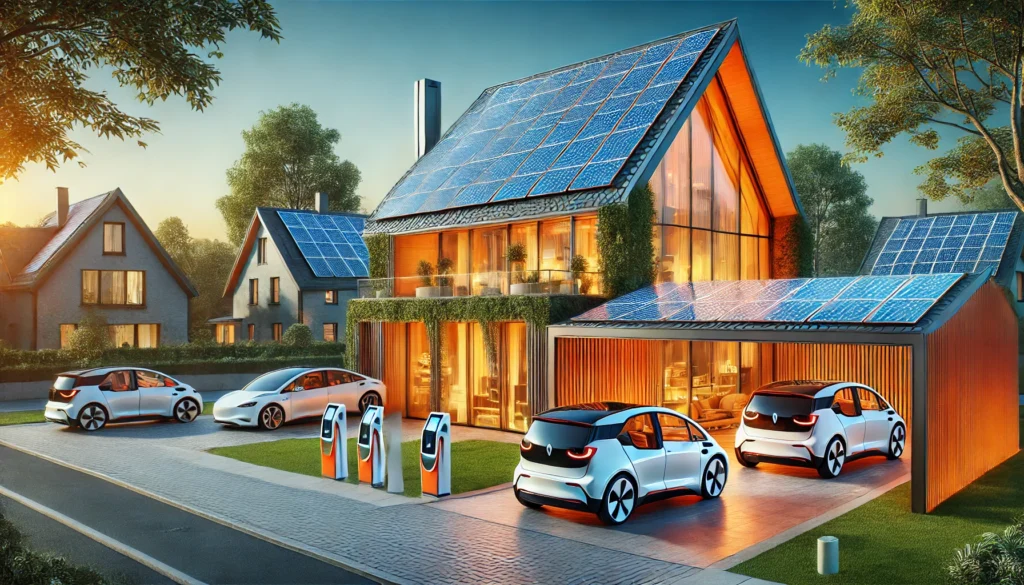In the next 5–10 years, homes will transform into highly adaptive, AI-driven ecosystems that seamlessly blend comfort, efficiency, and sustainability. With advanced HVAC systems, integrated EV charging, robotics, and a wide array of smart appliances, modern households are expected to see a significant increase in energy consumption. At the same time, the industrial trend toward building Virtual Power Plants (VPPs) is changing the way distributed energy resources interact with the grid. High-efficiency solar roofing systems, capable of delivering up to 200 kWh per day per home, are emerging as a key technology to bridge the energy gap and support both individual smart homes and the broader grid.
Will Every Household Consume 100 kWh Daily?
As homes become fully electrified and incorporate advanced technologies, a daily consumption of around 100 kWh per household is a realistic forecast. This can be broken down as follows:
- Base Load (≈30 kWh):
Traditional appliances such as refrigerators, televisions, computers, and lighting already account for a significant portion of energy consumption in modern homes. - Advanced HVAC Systems (≈20 kWh):
Next-generation, AI-powered HVAC systems will continuously monitor and adjust indoor environments—automatically managing temperature, humidity, and air quality. In regions like California, where comfort is a priority, these systems may add approximately 20 kWh per day. - EV Charging (≈40 kWh):
With the increasing adoption of electric vehicles, many households may have two EVs. Assuming each EV requires about 20 kWh per day for charging, this results in an additional 40 kWh per day. - Smart Devices and Robotics (≈10 kWh):
The proliferation of smart home devices—from AI assistants and health monitors to robotic vacuum cleaners and connected appliances—will contribute roughly another 10 kWh daily.
This breakdown demonstrates that in a future where every aspect of home living is optimized for efficiency and comfort, it is plausible for each household to consume approximately 100 kWh daily.
Bridging the Energy Gap and Enabling Virtual Power Plants (VPPs)
Currently, California’s generation capacity is roughly 712 GWh per day. In a future scenario where smart homes consume around 100 kWh daily and non-residential sectors add about 434 GWh per day, the total demand could reach approximately 1,884 GWh per day—leaving a deficit of around 1,172 GWh per day.
High-efficiency solar roofing systems that generate up to 200 kWh per day per installation can play a critical role in addressing this gap. Rather than expecting every household to install solar roofs immediately, a more realistic scenario might involve an initial 30% penetration among California’s 14.5 million households—approximately 4.35 million homes. With each system producing 200 kWh daily, the aggregate generation would be around 870 GWh per day. When managed as part of a Virtual Power Plant, these distributed resources can balance supply and demand, provide load regulation, and feed surplus energy back into the grid, thereby mitigating the overall energy shortfall and promoting sustainability.
Key Innovations and Features
1. Hyper-Personalized AI Integration
- Predictive Adjustments:
AI will learn individual routines and preferences, automatically optimizing lighting, temperature, and ambiance—for example, pre-cooling living spaces on hot days or dimming lights for movie nights. - Health-Focused Automation:
Future smart homes could include devices like smart mirrors and toilets that monitor vital signs, as well as furniture that helps correct posture and smart mattresses that optimize sleep quality. - Natural Interaction:
Advanced voice and gesture controls will make managing home systems as intuitive as having a conversation.
2. Seamless IoT Connectivity and Interoperability
- Universal Compatibility:
Open standards such as Matter will enable devices from different manufacturers to work together seamlessly, forming a unified smart home ecosystem. - Intelligent Everyday Objects:
Devices like refrigerators that track food expiration and motorized shades that adjust automatically based on sunlight will become standard. - Optimized Energy Management:
IoT sensors will coordinate with solar systems, HVAC, and EV charging stations to balance energy flow and maximize efficiency.
3. Robotic and AI-Driven Automation
- Autonomous Home Assistants:
Robotic chefs, cleaning robots, and smart maintenance systems will handle everyday chores, freeing residents from mundane tasks. - Predictive Maintenance:
AI will continuously monitor appliances, including HVAC systems, and schedule maintenance before issues escalate. - Advanced Humanoid Robotics:
By 2030, sophisticated humanoid robots may take on complex tasks such as childcare or elder care, integrating seamlessly with home automation systems.
4. Integrated HVAC and EV Automation
- Adaptive HVAC Systems:
AI-driven HVAC units will monitor indoor and outdoor conditions and dynamically adjust temperature, humidity, and airflow to create personalized microclimates while optimizing energy use. - Smart EV Charging:
Integrated EV charging systems will intelligently schedule charging based on surplus solar production and off-peak energy periods, reducing costs and easing grid load.
5. Enhanced Security, Privacy, and VPP Connectivity
- Biometric Access and Multi-Factor Authentication:
Advanced security measures such as facial recognition and fingerprint scanning will replace traditional keys. - Intelligent Surveillance:
AI-enhanced cameras will differentiate between routine activity and potential threats, triggering alerts and automated responses when necessary. - Data Security and VPP Integration:
A closed, secure system ensures that personal data is stored locally, while excess solar energy is aggregated into Virtual Power Plants to support grid stability.
6. Sustainability and Eco-Conscious Design
- Renewable Energy Synergy:
The combination of solar roofing with battery storage and VPP integration will substantially reduce reliance on fossil fuels and lower carbon emissions. - Eco-Friendly Retrofitting:
Plug-and-play design enables older buildings to upgrade to energy-efficient smart homes without extensive renovations. - Smart Energy Management:
AI-driven systems will ensure optimal energy flow and minimize waste, creating a zero-waste home environment.
7. Immersive and Adaptive Interfaces
- Advanced Displays:
Holographic and transparent OLED screens embedded in windows or mirrors will provide real-time data on weather, energy usage, and health metrics. - AR/VR and Future BCI:
Augmented reality interfaces will allow virtual interior design and interactive maintenance guides, while emerging brain-computer interfaces (BCIs) might eventually enable thought-based control.
Market Opportunity and Vision
In California, with roughly 14.5 million households, if an initial 30% adoption rate is achieved (approximately 4.35 million homes), the market potential is substantial. At an estimated installation cost of $25,000 per system, this initial phase could represent a market size exceeding $100 billion. Additionally, each installation’s 200 kWh daily output, aggregated across 4.35 million homes, would yield approximately 870 GWh per day—serving as a crucial component of a Virtual Power Plant that stabilizes the grid and meets future energy demands.
Conclusion
By 2035, smart homes are poised to become self-sufficient, adaptive “living organisms” powered by AI, IoT, robotics, and sustainable energy management. High-efficiency solar roofing systems, capable of generating up to 200 kWh per day, will not only meet the rising energy demands of advanced smart homes but also integrate into Virtual Power Plants to support a resilient and sustainable grid.


